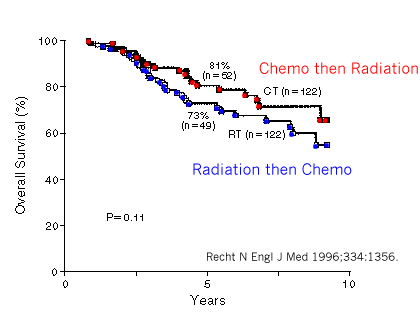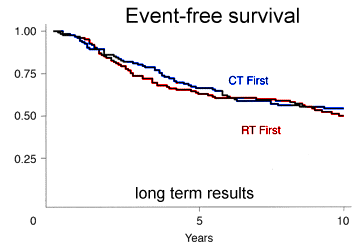|
|
Many patients treated with lumpectomy and radiation will also be candidates for chemotherapy. This includes most of the patients with lymph node metastases and patients with high risk tumors (1cm or larger, unfavorable DNA studies, hormone receptor negative) even if nodes are negative. It is possible to give both radiation and chemotherapy at the same time or in sequence. There is less toxicity if they are given in sequence but limited evidence about which should be given first.
In
general, since the study of Recht (chart on left) most therapists give the chemotherapy first and then radiation after
completion of all chemotherapy. There are studies using
concurrent chemotherapy plus radiation as
noted here. |
|
||
Phase III Trial of Concurrent or Sequential Adjuvant Chemoradiotherapy After Conservative Surgery for Early-Stage Breast Cancer: Final Results of the ARCOSEIN Trial
PURPOSE: In 1996, we initiated the French multicenter phase III randomized trial to compare the effect on disease-free survival (DFS) of concurrent versus sequential chemotherapy (CT) and radiotherapy (RT) after breast-conserving surgery for stages I and II breast cancer. This report presents the clinical results with a median follow-up of 60 months. PATIENTS AND METHODS: Between February 1996 and April 2000, 716 patients were entered onto this trial. Adjuvant treatment began within 6 weeks after surgery. Sequential treatment of CT administered first followed by RT was compared with concurrent treatment of CT administered with RT. The CT regimen consisted of mitoxantrone (12 mg/m2), fluorouracil (500 mg/m2), and cyclophosphamide (500 mg/m2) on day 1, and it was repeated every 21 days for six courses. RT was delivered to the breast and, when indicated, to the regional lymphatics. RESULTS: There was no statistically significant difference in treatment in the 5-year DFS (80%), locoregional recurrence-free survival (LRFS; 92% in sequential v 95% in concurrent), metastasis-free survival (87% in sequential v 84% in concurrent), or overall survival (90% in sequential v 91% in concurrent). Nevertheless, in the node-positive subgroup, the 5-year LRFS was statistically better in the concurrent arm (97% in concurrent v 91% in sequential), corresponding to a risk of locoregional recurrence decreased by 39% (hazard ratio, 0.61). CONCLUSION: This treatment protocol remains an appealing clinical option for many women with operable breast cancer at a high risk of recurrence. Combination treatments with new drugs for breast cancer are warranted.
|

